|
| |
Tachinid fly - Subfamily Goniinae
Family
Tachinidae
- This page contains pictures and information about Tachinid
Flies in subfamily Goniinae (or Exoristinae in some
reference) that we found in the Brisbane area, Queensland, Australia.
-
 -
- The Goniinae are mostly parasitic in larvae of Lepidoptera (moth and
butterfly), with a few species parasite on adult beetle
and larvae of paper wasp.
-
- In this group most species are grayish black in color and moderately bristly.
The head does not have the facial carina. Many of them have the very
large pre-alar seta (a seta at outside corner of scutum). Different species
might look very similar and hard to be distinguished. They are usually found
hunting on leaves and flying between plants.
-
-


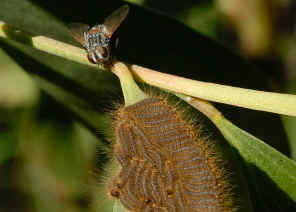
-
- Flies in subfamily Goniinae can be identified by the following characteristic;
- - head without facial carina
- - uppermost eye facets not enlarged,
- - reclinate orbital setae present,
- - eyes bare or haired,
- - vibrissae well developed,
- - arista bare or micropubescent, rarely plumose,
- - humeral callus with two or more setae,
- - many have very large pre-alar seta,
-
Acemyini
- - small pre-alar seta,
- - three pair of very strong setae on scutellum, apical crossed,
- - bend of vein M widely obtuse,
- - 2+3 dc setae,
- - parasites of grasshoppers,
Neaerini
- Flies in this tribe have the following characteristic;
- - small pre-alar seta,
- - two pairs of scutellum strong setae, subapical scutellar setae crossed,
- - costal margin broken and incised at Sc,
- - abdomen T3 to T5 each with strong erect setae,
-
- Grey Tachinid Fly I

 - Voriella sp., body length 8mm
- The fly is grey in colours with black patterns. Its eyes covered with short
hairs. There are two pairs of strong setae on scutellum with subapical scutellar setae
crossed. On abdomen T3 to T5 each with strong erect setae. Please check this page
for more information on this fly.
-
-
 -
-

 -
-
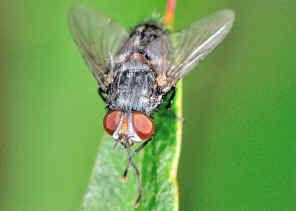
 -
 -
 
 -
Blondeliini
- Flies in this tribe have the following characteristic;
- - small pre-alar seta,
- - subapical scutellar setae strong,
- - most have the bend of vein evenly round although a few rather abruptly
angular,
-
- Australian Leafroller Tachinid
  - Trigonospila brevifacies, body length 6mm
- This fly has the zebra pattern with interesting black and white colour strips.
The fly has strong erect discal setae on abdomen. Please check this page
for more pictures and information.
-
-
- Cylindrical Tachinid
Fly

 - ? sp., body length 8mm
- This fly is banded with black and grey colours. It has the broad lower
calypter. The abdomen is narrow and elongated cylindrical shape. The wings
are slightly tinted with brown colour. Please check this page
for more information.
Exoristini
- Flies in this tribe have the following characteristic;
- - small pre-alar seta,
- - M2 continuing towards the wing margin,
-
- Blue Hairy Tachinid Fly
  - Exorista sp., body length 8mm
- This fly is bluish-grey in colour with metallic reflection under sun light.
We have more information and pictures in this page.
-
-
- Black Hairy Tachinid Fly
 - ? Exorista sp., body length 8mm
-
Ethillini
- Flies in this tribe have the following characteristic;
- - small pre-alar seta,
- - eyes densely haired,
Winthemiini
- Flies in this tribe have the following characteristic;
- - long pre-alar seta,
- - Winthemiini, Carceliini and Sturmiini are
closely related groups,
- - hairy eyes,
- - scutellum with strong
horizontal crossed apical setae and with the subapical setae,
-
- Hairy-eyed Grey Tachinid Fly
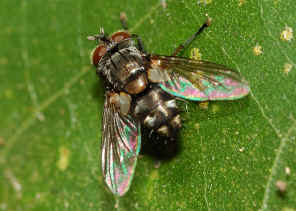 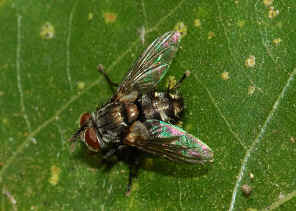 - Winthemia sp., body length 6mm
- One characteristic of this fly
is its hairy eyes.
-
-

 -
-
 -
 -
-
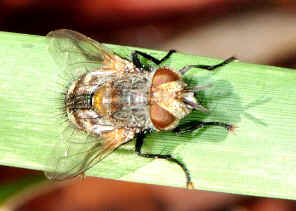

 -
 -
Carceliini
- Flies in this tribe have the following characteristic;
- - long pre-alar seta,
- - eyes bare or haired,
- - some forms closely resemble Winthemiini,
-
- Processionary
Caterpillar Parasitic Fly

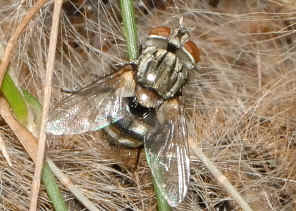
- Carcelimyia
dispa,
body
length 8mm
- Processionary Caterpillars
are parasited by the this Processionary
Caterpillar Parasitic Fly Carcelimyia dispar.
Details please check this page.
-
-
- Grey Tachinid Fly II
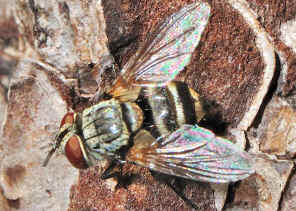 - ?
Carcelimyia sp.,
body
length 8mm
-
-
- Grey Tachinid Fly III
-
 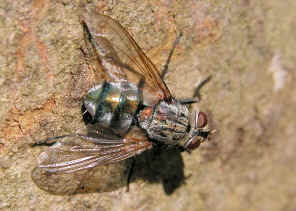
- ?
Carcelimyia sp.,
body
length 8mm
Sturmiini
- They are Tachinid flies with
grey hairy body in this tribe. They are 8-10mm in body length. They look similar
and difficult to identify. When we raised moth and butterfly
caterpillars, they often came out from pupa instead of moths or butterflies.
-
- Flies in this tribe have the following characteristic;
- - well represented in Australia.
- - large pre-alar seta,
- - vibrissae inserted at above,
- - 3+4 dc setae
-
- Grey Tachinid Fly IV
-


- ? Anamastax sp, body length 8mm
-
-
- Grey Hairy Tachinid Fly


- ? Winthellia sp., body length 8-10mm
-
-
- Small Grey Hairy Tachinid Fly
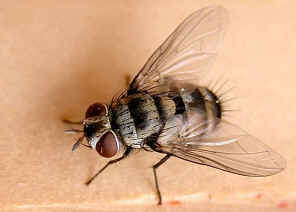

- Palexorista sp., body length 8mm
- This Tachinid Fly is parasite on butterfly caterpillar.
-
-
- Grey Tachinid Fly V
-
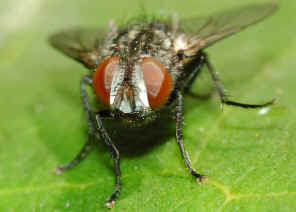

- ? sp., body length 6mm
-
Goniini
- Flies in this tribe have the following characteristic;
- - large pre-alar seta,
- - strong reclinate ocellar setae,
- - a pair of erect setae on scutellum,
- - wide frons,
- - eyes bare,
- - 3+4 dc setae,
-
- Grey Tachinid Fly VI
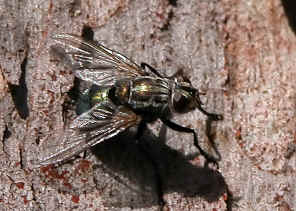 - ? sp., body length 10mm
-
-

-
- Reference:
- 1. Family TACHINIDAE - Australian Biological Resources Study, Australian Faunal Directory.
- 2. A revisionary classification of the Rutiliini (Diptera: Tachinidae), : with keys to the described species - R. W. Crosskey, British Museum (Natural History),
Bulletin, Entomology, Supplement 19, 1973.
- 3. A conspectus of the Tachinidae (Diptera) of Australia, including keys to the supraspecific taxa and taxonomic and host catalogues - R. W. Crosskey, British Museum (Natural History),
Bulletin, Entomology, Supplement 21, 1973.
-
- Back to Top
-
- [ Up ] [ Phasiinae ] [ Dexiinae ] [ Tachininae ] [ Goniinae ] [ Unknown Tachinid fly ] [ More about Tachinid flies ]
| |
|














































